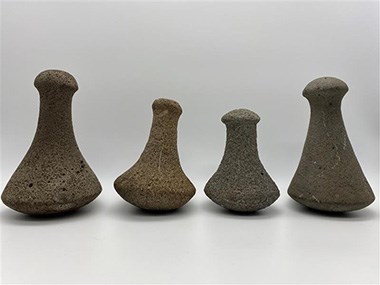
NPS Photo For 900 years Hawaiian people lived and thrived on the Kalaupapa peninsula. Archaeological evidence of their lives and connection with the ʻaina, or land, is everywhere. Common features found around the peninsula are the remains of house sites, taro fields and irrigation systems, stone walls, and temples. Historical accounts from the early to mid-1800s speak of populations of 1,000 to 2,700 people living on the peninsula, in the valleys, and in the villages. Several stories and legends connected with this land tell of events occurring before European contact. The ahupuaʻa is the basic land division in traditional Hawaiian society. Within this division, running from the uplands (mauka) to the sea (makai), could be found all of the resources needed to sustain Hawaiian life. People gathered sea salt and caught fish and other marine life from the ocean and tidal pools, conducted agriculture on the dry lands and wet valleys, obtained fresh water from perennial streams, and harvested the hardwood forests for many uses, including houses and canoes. There are three ahupuaʻa on Kalaupapa peninsula, but four are within the boundary of the National Historical Park's boundary. The natural environment and resources found within the ahupuaʻa of Kalaupapa, Makanalua, Kalawao and Waikolu were rich enough to support human habitation for hundreds .of years. For Hawaiians involved with agriculture, there were three types of land available for growing crops. Ko Kaha Kai was land along the shoreline. Kula lands were on the lands above the shoreline. Kahawai lands were in the valleys, where fresh water could also be obtained. At Kalauapapa the kula lands were important for growing ʻuala, or sweet potatoes. It is not known how or when sweet potatoes arrived in Hawaii from South America, but after European contact, early visitors to Kalaupapa remarked on the numerous potato patches and stone windrows. In 1854, French botanist Jules Remy visited the village of Kalaupapa and remarked, "Not having seen in the fields of Kalaupapa coconut trees, pandanus, taro, I asked these people why these were not planted. They replied that it was not their custom, and as regards the taro, the ground was not suitable for its cultivation; it produced potatoes in any amount at will and these could be readily exchanged for products cultivated in Waikolu." Kalaupapa sweet potatoes were exported not just throughout the Hawaiian Islands but to California as well. During the gold rush years of 1849-1851 ships came directly from San Francisco to Kalaupapa to load sweet potatoes to feed the booming mining population. The potato exports lasted until Kalaupapa Peninsula's history changed forever in 1866. If Kalaupapa Peninsula and its neighboring valley once supported a sizeable population, the number of people living there when the isolation settlement was established at Kalawao was much smaller. As throughout the rest of Hawaii, a series of epidemics in the mid- to late 1800s decimated the Hawaiian population. By 1853 about 140 people lived in the village of Kalaupapa. In 1866, when the first patients were left at Kalawao, the remaining original inhabitants were subsequently moved following the sale of their lands to the Board of Health. By 1900 non-patient Hawaiians were gone from the entire peninsula. Nine hundred years of connection with the ʻaina was broken. |
Last updated: December 19, 2022
